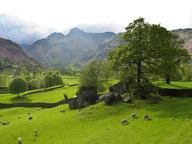Quiz Answer Key and Fun Facts
1. Hobcarton Crag is described by Wainwright as being quiet, although he does include a warning that readers should look out for falling botanists! This crag forms the ridge route between which two fells?
2. Which hill in the Newlands valley did Wainwright call the 'Shivering mountain' due to the constant slight movement of mine spoil heaps, which can (allegedly) be heard to this day?
3. On which hill are there monuments to Thomas Arthur Leonard and Hugh Walpole, as well as a path named Woodford's Path?
4. On the Ordnance Survey map the following names appear: Robin's Fold, Wilson's Bield and Joe Bank's Fold. All three are sheepfolds. On which fell, which Wainwright informs us has the alternative name of Scawdel Fell, are these found?
5. The lowest of all the 214 Wainwrights lies in the Jaws of Borrowdale. It is noted for caves which the mountaineer Millican Dalton used as a summer residence. Which hill is this?
6. Which mountain is separated from its subsidiary peak of High Snockrigg by Buttermere Moss?
7. The Walton Memorial in Wythop Wood has nothing to do with the composer William Walton and everything to do with a head forester named Wilfred Walton. On which hill, the most northerly of the north-western fells, can this be found?
8. The remains of the only cobalt mine to have existed in the Lake District are to be found on the north flank of which mountain?
9. Which mountain has two whitewashed rocky pinnacles named Bishop and Clerk?
10. To who, whom or what did Alfred Wainwright dedicate Book 6 of his 'Pictorial Guide to the Lake District'?
Source: Author
paper_aero
This quiz was reviewed by FunTrivia editor
gtho4 before going online.
Any errors found in FunTrivia content are routinely corrected through our feedback system.

